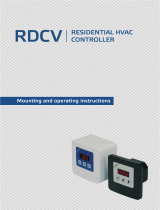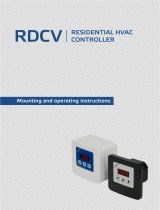Page is loading ...

$/($0$*,1$,)$+,(# )3$ +#$/($0,)$+,(# )3$+"),02/$
-$"(%(" 1(,+0+01 )) 1(,+ +#-$/ 1(+&+01/2"1(,+0
2))$1(+
DWYER INSTRUMENTS, INC.
Phone: 219/879-8000 www.dwyer-inst.com
'$$/($0(),1,)$+,(# )3$ is used to operate the Series
RDCV remote type diaphragm valve. Series RDCV does not include an
integral solenoid and needs to be activated remotely. The RSV can drive
all size diaphragm valves. The units can be bought separately for mount-
ing in a panel or can be purchased mounted on our SVE enclosure. Con-
sult factory for mounting of RSV valves with our DCT timer boards
together in one enclosure all pre-wired.
'$$/($0 are multi-valve enclosures for the RSV pilot valve. The
SVE offers a convenient weatherproof enclosure package with all sole-
noids pre-wired to a terminal block. Enclosures are available in 6 or 12
valve size with choice of pilot valve voltage.
$/3("$(For RSV) Compatible gases, filtered and oil free.
$11$# 1$/( )0 (For RSV) Body: aluminum; Core and spring: 304
SS; Seals: NBR.
/$002/$(*(10(For RSV) Minimum of 4.4 psi (0.3 bar), maximum of
124.7 psi (8.6 bar).
$*-$/ 12/$(*(10Ambient: -4 to 122°F (-20 to 50°C); Operating: -4
to 185°F (-20 to 85°C).
,4$/$.2(/$*$+1(For RSV) 110 VAC, 220 VAC, or 24 VDC.
,4$/,+02*-1(,+(For RSV) 12 W, inrush: 17 VA, holding: 14.5
VA.
+"),02/$ 1(+&NEMA 4X (IP65).
+"),02/$ 1$/( )Anodized aluminum with NBR gasket.
)$"1/(" ),++$"1(,+All RSV are pre-wired to a terminal strip.
/,"$00,++$"1(,+(For RSV) 1/8˝ NPT female. (Consult factory for
1/4˝ NPT).
,+#2(1,++$"1(,+ 3/4˝ NPT female.
,2+1(+&/($+1 1(,+ Any position.
+$2* 1("2!$$+&1' Maximum of 9.8 ft (3 m).
$/3("$Compatible gases, filtered and oil free.
$11$# 1$/( )0Body: aluminum; Core and spring: 304 SS; Seals:
NBR.
/$002/$(*(10Minimum of 4.4 psi (0.3 bar), maximum of 124.7 psi
(8.6 bar).
$*-$/ 12/$(*(10 Ambient: -4 to 122°F (-20 to 50°C); Operating: -4
to 185°F (-20 to 85°C).
,4$/$.2(/$*$+10110 VAC, 220 VAC, or 24 VDC.
,4$/,+02*-1(,+612 W, inrush: 17 VA, holding: 14.5 VA.
+"),02/$ 1(+&NEMA 4X (IP65).
)$"1/(" ),++$"1(,+DIN connection or wire leads, 18 AWG, 22˝ (55
cm) long.
/,"$00,++$"1(,+1/8˝ female NPT.
,2+1(+&/($+1 1(,+ Any position.
$(&'1 0.60 lb (0.27 kg).
+$2* 1("2!$$+&1' Maximum of 9.8 ft (3 m).
13/16
[21]
1-21/32
[42]
1-1/8
[32]
5/8
[16]
25/32
[19.5]
1-1/2
[38.5]
2-9/32
[83.5]
(WIDTH)
1-11/32
[34]
B
D
A
C WIDTH
,#$)
2*!$/
)$"1/(" )
,++$"1(,+0
DIN
DIN
DIN
Wire Leads
Wire Leads
Wire Leads
,)1 &$
110 VAC
220 VAC
24 VDC
110 VAC
220 VAC
24 VDC
3
.33
.33
.33
.33
.33
.33
SVE06WP61
SVE06WP61
C WIDTH
D
A
B
,#$)
2*!$/
+"),02/$5-$
Weatherproof
Weatherproof
Weatherproof
Weatherproof
Weatherproof
Weatherproof
2 +1(15,%
,)$+,(#
6
6
6
12
12
12
,)1 &$
110 VAC
220 VAC
24 VDC
110 VAC
120 VAC
24 VDC
,#$)
2*!$/
**
10-5/8˝ (270)
18-29/32˝ (480)
**
4-11/64˝ (106)
4-11/64˝ (106)
**
6-5/16˝ (160)
6-5/16˝ (160)
**
9-7/32˝ (234)
17-9/16˝ (446)

/+(+& Before installation make sure all air pressure has
been released, electric power has been turned off, and air pres-
sure source has been closed. Turn power on and increase pres-
sure only after installation is completed.
Select a location that will not exceed the ambient temperature specifica-
tions of the valve. The system must be located in an enclosure that meets
relevant safety standards and electrical codes of the environment.
1. Disassemble RSV solenoid valve by removing top nut and washer. Re-
move solenoid body and finally remove lower nut.
2. Make a hole in the panel that is .76 to .81˝ (19.5 to 20.5 mm) in diam-
eter. (Panel thickness can be from .04 to.15˝ (1 to 4 mm)).
3. Place valve body/tube through the panel hole from the outside and
tighten down lower nut onto the body threads from the inside.
4. Replace solenoid and washer. Tighten down with top nut to hold down
the solenoid.
The RSV can be mounted in any position. For optimum life and perfor-
mance it is recommended that the unit be mounted vertically and upright
to reduce the chance of foreign matter accumulating in the valve. For
weatherproof applications it is recommended the cable gland be posi-
tioned face down to avoid possible rainfall or water from entry.
Verify that the supply pressure is within the required specification. Do not
turn on the system before installation is complete. Make sure that there
is no dirt or other particulates between the RDCV diaphragm valve and
the connections of the RSV, remote solenoid valve, which would cause a
restriction of airflow. There should be no condensed water in the piping.
The use of a filter may be required to avoid this problem. Leak testing
should be done prior to installation only.
Wire in accordance with the National Electrical Code and local regula-
tions.
RSV
To aid in the wiring, the solenoid on the RSV may be rotated 360°. Pre-
wired models come standard with 22˝ (55 cm) of 18 AWG wire. For un-
wired models it is recommended to use 18 AWG copper wire rated at
90°C or greater.
Wiring the RSV with DIN connector. See Figure 1.
1. Remove center screw and pull wiring assembly from the body.
2. Remove gasket and place small screw driver in slot to pry out the ter-
minal block from the cover.
3. Thread wire through the gland nut, gland gasket, washer and connec-
tor cover.
4. Connect wires to proper terminals on the terminal block.
5. Snap terminal block back into the cover. The connector cover may be
rotated in 90° increments to position the cable entry as needed for the
application. Reinstall the center screw and screw back into the solenoid
body.
Wiring the SVE
The SVE comes from the factory with the RSV solenoids wired to a ter-
minal block. Connect 18 AWG copper wire rated at 90°C or greater to the
screw terminal block. Ground screw is provided on the terminal block.
The enclosure has a 3/4˝ NPT female conduit connection. When wiring
is complete reinstall cover making sure that the gasket is in place. Tight-
en all screws in a crisscross manner.
Warning: To prevent the possibility of death, serious injury or property
damage, turn off electrical power, depressurize system and unit, and
vent fluid to a safe area before servicing.
The RSV should be cleaned periodically. The amount of time between
cleanings depends on the application. Preventive Maintenance includes
keeping media clean of material and oil free, and periodic testing to in-
sure proper operation and to look for wear or damage.
Upon final installation of the Series RSV Remote Solenoid Valve and the
Series SVE Solenoid Valve Enclosure, no routine maintenance is re-
quired. A periodic check of the system calibration is recommended. The
Series RSV and Series SVE are not field serviceable and should be re-
turned if repair is needed (field repair should not be attempted an may
void warranty). Be sure to include a brief description of the problem plus
any relevant application notes. Contact customer service to receive a re-
turn goods authorization number before shipping.
©Copyright 2014 Dwyer Instruments, Inc. Printed in U.S.A. 9/14 FR# RV-443335-00 Rev.2
DWYER INSTRUMENTS, INC.
Phone: 219/879-8000 www.dwyer-inst.com
/,!)$*
No pulse
Leakage in outlet port
Low pulse
Shaking noise
Solenoid noise
,00(!)$ 20$
No supply air
Air pressure is too high
No voltage to RSV
Solenoid is damaged
Improper installation of inlet port
Low air pressure
Valve screws are loose
Solenoid mounting screws are loose
"1(,+$.2(/$#
Check whether the air compressor and valve have been turned on
Check the pressure of the air supply
Check supply voltage
Send back for evaluation
Check the pipe connections between the inlet and outlet
Check air supply pressure
Verify that the air supply was distributed properly
Tighten the loose screws
Tighten the loose screws
,)$+,(# )3$/,2!)$0',,1(+&
(&2/$
/



